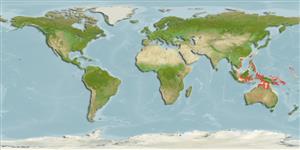Teleostei (teleosts) >
Gobiiformes (Gobies) >
Gobiidae (Gobies) > Gobiinae
Eponymy: Professor Cornelius Jan van der Horst (1889–1951) was a Dutch zoologist who moved to South Africa (1928) and became Head of the Zoology Department, Witwatersrand University, Johannesburg. [...] (Ref. 128868), visit book page.
More on author: Randall.
Environment: milieu / climate zone / depth range / distribution range
Ecology
Marine; benthopelagic; depth range 20 - 38 m (Ref. 78591). Tropical
Western Pacific.
Size / Weight / Age
Maturity: Lm ? range ? - ? cm
Max length : 4.0 cm SL (female)
Short description
Identification keys | Morphology | Morphometrics
Dorsal spines (total): 7; Dorsal soft rays (total): 17; Anal spines: 1; Anal soft rays: 18. This species is distinguished by the following characters: D VI-I, 17; A I, 18; pectoral rays 18; scales in longitudinal series 78; scales absent on head, nape, or prepectoral area; body elongate, its depth 6.6 in SL; dorsal spines progressively longer to fourth, 4.05 in SL; caudal fin pointed and moderately long, 3.0 in SL; pectoral fins reaching to above anus, 3.8 in SL; pelvic fins not reaching anus, 4.65 in SL (Ref. 75899); characterized further by male with bluish body color, white abdomen, head and body covered with yellow spots, blue mid-dorsal stripe on head, yellow spotting on dorsal fin; female similar to male except for having irregular dark spots on first dorsal fin and yellow streaks instead of spotting; united pelvic fins, presence of well developed frenum; body covered with cycloid scales anteriorly, ctenoid posteriorly (Ref. 90102).
The alpheid Alpheus cf rapacida is the symbiotic snapping shrimp that shares the burrows with this species in both Papua New Guinea and Majuro (Ref. 78591). Found in estuaries, lagoons and sheltered reefs (Ref 90102).
Life cycle and mating behavior
Maturity | Reproduction | Spawning | Eggs | Fecundity | Larvae
Randall, J.E., 2007. Descriptions of four new shrimpgobies of the genus Vanderhorstia from the Western Pacific. aqua, Int. J. Ichthyol. 12(3):89-100. (Ref. 75899)
IUCN Red List Status (Ref. 130435: Version 2024-2)
Threat to humans
Harmless
Human uses
Tools
Special reports
Download XML
Internet sources
Estimates based on models
Preferred temperature (Ref.
123201): 26.5 - 28.5, mean 27.4 °C (based on 28 cells).
Phylogenetic diversity index (Ref.
82804): PD
50 = 0.5000 [Uniqueness, from 0.5 = low to 2.0 = high].
Bayesian length-weight: a=0.00724 (0.00339 - 0.01546), b=3.10 (2.92 - 3.28), in cm total length, based on LWR estimates for this (Sub)family-body shape (Ref.
93245).
Trophic level (Ref.
69278): 3.2 ±0.3 se; based on size and trophs of closest relatives
Resilience (Ref.
120179): High, minimum population doubling time less than 15 months (Preliminary K or Fecundity.).
Fishing Vulnerability (Ref.
59153): Low vulnerability (10 of 100).
